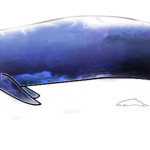Think of the changing seasons around you, and the way plants and animals respond to these changes. Trees change color in response to decreasing light levels. Birds migrate, and bears go into hibernation as winter approaches. So, we wonder, what are the seasonal cues in the abyss? Are summer days longer than winter days in the deep-sea? What’s the ocean equivalent of rainfall, anyhow?
If you’ve read Craig McClain’s “25 Things You Should Know About the Deep-Sea” you know that a) the deep sea-floor is not a stable environment and b) processes and patterns are linked to surface production. Therefore, benthic organisms in the deep-sea will experience variable conditions, not so much in terms of temperature, but in terms of bottom currents forced by winds, tides, and passing eddies. Food availability will also vary depending on primary production at the surface, itself a function of light and nutrient supply. Upwelling systems are seasonal. They bring nutrients up from the deep (NO3 and PO4) in water masses driven by sustained surface winds and Coriolis force. A phytoplankton bloom results, followed by zooplankton, and the food rains down from above.
The problems documenting these effects in the deep-sea using longitudinal (extended duration) studies in fall into two categories: accessibility and expense. Only a few places in the world (like MBARI and Scripps) have facilities adjacent to a water column deeper than 200m, and of those, only a few have the assets (boats, moorings, ROVs, and subs) to explore those waters on a regular basis. So what’s a researcher to do? A new study says “look to the sponges” to find your springtime in the abyss.
“Corallistes undulates is a large, cup-shaped sponge that lives attached to rocks in the deep ocean,” says Dr Michael Ellwood from The Australian National University.
“Sponges are animals that grow by filtering particles out of the water around them to aid in the building of their glass skeletons. The fact that they must draw their sustenance from the water about them means that they act as environmental recorders, keeping ‘histories’ of the ocean about them.”
The scientists used dating techniques to determine that their samples of the sponge were between 135 and 160 years old – an age range than matched closely to the number of silica density bands in the sponge, which were identified using x-ray technology.
“Our research also shows that there are annual patterns in the fluctuation of trace elements, which suggests that something akin to ‘seasons’ might be occurring under the ocean.”
And when spring arrives, … all the mermaids come out to play. ; )

Read the full story here from ScienceAlert Australia and New Zealand
First reported here in a NIWA newsletter in 2003.
Picture of spring underwater from Supergrass video at Wikki Wachee. Watch it here.
Special bonus for reading to the end.






“Spring time for the Abyss”is even catchier than “Springtime for Hitler”.
hi i love u xx from jade xx
i like the pic its cool and i love under the see but i dnt like scooba divin (wierd)
hiya wots wif the pic xxdxx